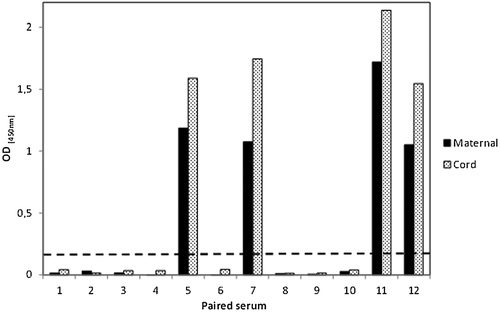Antibodies to hepatitis E in Portuguese mothers and their newborns
Abstract
The high mortality of pregnant women is one of the main features of hepatitis E virus (HEV) infection in endemic countries. With the emergence of genotype 3 HEV in industrialized countries, attention should be given to pregnant women from these regions since the effect of genotype 3 HEV in pregnancy is not yet known. In this study, archived sera dating from 1993 from mothers with no history of traveling to HEV endemic countries and their newborns were tested for anti-HEV IgG antibodies. Four of the 12 maternal sera were positive for IgG anti-HEV, indicating exposure to this virus. Their newborns were also positive, showing higher anti-HEV IgG levels. Overall, these findings demonstrate not only an efficient transplacental transport of anti-HEV IgG, but also circulation of autochthonous HEV in Portugal in the early 1990s. J. Med. Virol. 85:1377–1378, 2013. © 2013 Wiley Periodicals, Inc.
Hepatitis E virus (HEV) infections in industrialized countries were until recently only considered in those who have traveled to an HEV endemic region. However, the discovery of autochthonous hepatitis E in industrialized countries associated to genotype 3 has substantially changed the understanding about HEV circulation [Teshale et al., 2010; Hoofnagle et al., 2012; Kamar et al., 2012].
The high mortality of pregnant women (10–25%) is one of the main features of HEV infection (genotypes 1 and 2) in endemic countries [Teshale et al., 2010; Hoofnagle et al., 2012; Kamar et al., 2012]. With the emergence of genotype 3 HEV in Europe and United States, attention should be given to pregnant women since the effect of acute hepatitis E in pregnancy, due to genotype 3 is not yet known. In the only acute HEV genotype 3 infection reported in a pregnant woman, the mother had a spontaneous good outcome [Anty et al., 2012].
Recent studies of HEV seroprevalence in Europe and United States in adult population have shown values ranging from 16% to 21%, suggesting a high HEV exposure to an autochthonous (locally acquired) genotype [Faber et al., 2012]. Thus, it is expected that autochthonous HEV also circulate among pregnant women in Europe. Interestingly, HEV seropositivity rates reported in the 1990s in Europe have shown to be much lower (1.1–5.2%) than the ones found today [Bendall et al., 2010]. Whether this difference represents a true emergence of HEV genotype 3 in developed countries in the past decades or an increased sensitivity of modern immunoassays is yet to be known.
Hence, the main goal of the present work was to search for the presence of anti-HEV IgG antibodies in sera, from Caucasian mothers and their newborns, collected between November and December of 1993, allowing inferring past circulation of this virus in Portugal in the 1990s. Moreover, the evaluation of anti-HEV IgG levels in paired mothers/newborns will inform about the transplacental transmission efficiency of these viral specific antibodies to newborns. These archived sera were from a study on vertically transmitted antibodies against measles [Gonçalves et al., 1999, 2006]. Maternal blood samples were collected at delivery by venepuncture and newborn samples were obtained from blood of the umbilical cord. When specifically inquired, the mothers (aged from 16 to 35 years-old) reported no hepatic problems during pregnancy and no history of traveling to HEV endemic countries. The detection of anti-HEV IgG antibodies was performed using a commercial ELISA (Wantai Biological Pharmacy Co.®, Beijing, China).
Four of the 12 maternal sera were positive for IgG anti-HEV, indicating previous exposure to this virus. Their newborns were also positive, showing higher anti-HEV IgG levels, based on optical densities; Fig. 1). A positive correlation between paired maternal and newborn IgG anti-HEV levels was observed (r = 0.9917, P < 0.0001, GraphPad Software, San Diego, CA). These findings demonstrate an efficient transplacental transport of anti-HEV IgG and a concentration in the fetal side.

Overall, results from this study show that HEV circulated in Portugal in the early 1990s. Since immunoassays do not differentiate between HEV genotypes 1 and 3 (there is only one serotype of HEV) we cannot safely state about the HEV genotype responsible for the observed seropositivity. However, we can speculate that IgG anti-HEV detected in the studied women resulted from an infection with an autochthonous HEV genotype since they had no history of traveling to HEV endemic countries. Autochthonous HEV circulation in Portugal in the 1990s is supported by a study performed at this decade, showing anti-HEV in Portuguese adults with no history of traveling to HEV endemic countries [Lecour et al., 1999]. With the circulation of genotype 3 HEV in industrialized countries, it becomes imperative to consider hepatitis E in pregnant women when biochemical markers of liver dysfunction are detected.
ACKNOWLEDGMENTS
We thank Wantai Biological Pharmacy Co., Beijing, China, for providing the anti-HEV IgG ELISA diagnostic kits.




